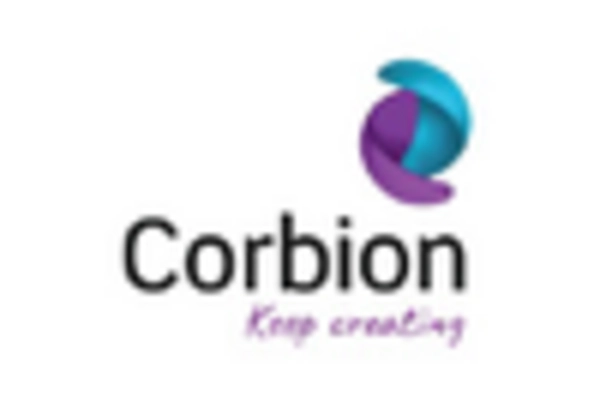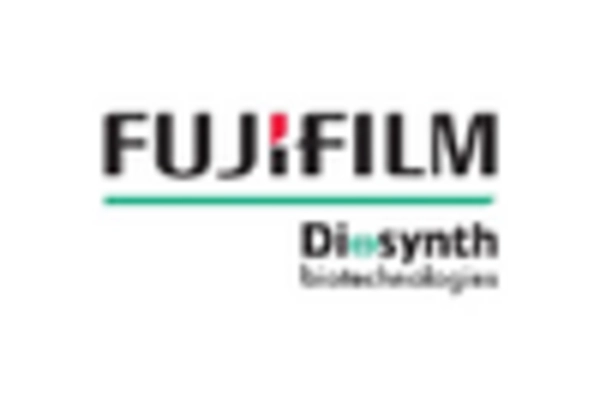Advancements in Tissue Engineering
The Poly Lactic Co-Glycolic Acid PLGA Market is significantly influenced by advancements in tissue engineering. PLGA's unique properties, such as tunable degradation rates and mechanical strength, make it a preferred material for scaffolds in regenerative medicine. The increasing focus on developing biocompatible materials for tissue regeneration is driving the demand for PLGA-based products. Recent studies indicate that the tissue engineering market is expected to reach USD 20 billion by 2026, with PLGA playing a pivotal role in this growth. The ability of PLGA to support cell attachment and proliferation enhances its application in various tissue types, including bone, cartilage, and skin. As researchers continue to explore innovative applications, the Poly Lactic Co-Glycolic Acid PLGA Market is likely to expand in tandem with these advancements.
Rising Demand in Drug Delivery Systems
The Poly Lactic Co-Glycolic Acid PLGA Market is experiencing a notable surge in demand for drug delivery systems. This is primarily due to the increasing prevalence of chronic diseases and the need for effective therapeutic solutions. PLGA's biocompatibility and biodegradability make it an ideal candidate for encapsulating drugs, allowing for controlled release and improved patient compliance. According to recent data, the market for drug delivery systems utilizing PLGA is projected to grow at a compound annual growth rate of approximately 8.5% over the next five years. This growth is indicative of the broader trend towards personalized medicine, where PLGA plays a crucial role in enhancing the efficacy of treatments. As healthcare providers seek innovative solutions, the Poly Lactic Co-Glycolic Acid PLGA Market is poised to benefit significantly from this rising demand.
Growing Interest in Biodegradable Polymers
The Poly Lactic Co-Glycolic Acid PLGA Market is benefiting from the growing interest in biodegradable polymers. As environmental concerns rise, industries are increasingly seeking sustainable alternatives to traditional plastics. PLGA, being a biodegradable polymer, aligns with the global shift towards eco-friendly materials. The market for biodegradable polymers is projected to grow at a CAGR of 10% over the next decade, with PLGA being a key player. This trend is particularly evident in packaging applications, where companies are looking to reduce their carbon footprint. The versatility of PLGA allows it to be used in various applications, from medical devices to consumer products. As sustainability becomes a priority for manufacturers, the Poly Lactic Co-Glycolic Acid PLGA Market is likely to see substantial growth driven by this demand.
Regulatory Support for Biocompatible Materials
The Poly Lactic Co-Glycolic Acid PLGA Market is positively impacted by regulatory support for biocompatible materials. Regulatory agencies are increasingly recognizing the importance of biocompatible polymers in medical applications, leading to streamlined approval processes for PLGA-based products. This support is crucial for manufacturers looking to bring innovative solutions to market quickly. Recent regulatory changes have facilitated the introduction of new PLGA formulations, enhancing their applicability in drug delivery and tissue engineering. As the regulatory landscape continues to evolve, it is expected that the market for PLGA will expand, driven by the increasing acceptance of biocompatible materials in various applications. The Poly Lactic Co-Glycolic Acid PLGA Market is likely to thrive as a result of this supportive environment.
Increased Investment in Research and Development
The Poly Lactic Co-Glycolic Acid PLGA Market is witnessing increased investment in research and development activities. This trend is largely driven by the need for innovative applications and improved product performance. Companies are allocating significant resources to explore new formulations and processing techniques that enhance the properties of PLGA. Recent reports suggest that R&D spending in the polymer sector is expected to rise by 15% annually, reflecting the industry's commitment to innovation. This investment is crucial for developing advanced PLGA-based products that meet the evolving needs of various sectors, including healthcare and packaging. As the market continues to evolve, the Poly Lactic Co-Glycolic Acid PLGA Market stands to gain from these advancements, fostering a competitive landscape that prioritizes innovation.


















Leave a Comment